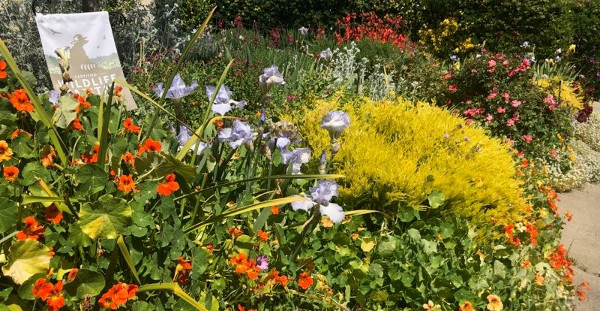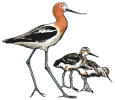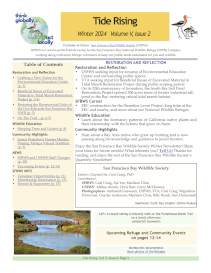National Wildflower Week: May 3 - 9, 2021 - Create a Pollinator Garden
The first full week of May is National Wildflower Week, May 3 through 9 this year. It is a time when gardens are blooming with flowers.
Pollinators visit flowers to drink nectar or feed off of pollen and transport pollen grains as they move from spot to spot. Birds, bats, butterflies, moths, flies, beetles, wasps, small mammals, and most importantly, bees are pollinators.
Pollinators play a crucial role in flowering plant reproduction and in the production of most fruits and vegetables. Without the assistance of pollinators, most plants cannot produce fruits and seeds. The fruits and seeds of flowering plants are an important food source for people and wildlife.
A wonderful way to support local pollinators is to create a pollinator garden.

Pollinator garden. Photo Credit: Olivia Poulos / SFBWS
A pollinator garden attracts bees, butterflies, moths, birds and other creatures that move pollen from one plant to another. The pollinators are declining due to a loss of habitat and the use of chemicals such as insecticides and pesticides. Establishing a pollinator garden, small or large, can make a huge difference in supporting the survival of pollinators. Here are some recommendations and resources in creating your own powerful pollinator garden.
Get to know your pollinators
Take a look out your window or spend time outside to observe and investigate what pollinators are in your area. Being familiar with local pollinators will help you decide what plants and resources are best for them.
Grow native and pollinator-friendly flowering plants
Flowers provide the nectar and pollen the pollinators feed on; native plants are adapted to survive in your unique landscape. Native plants can also help with erosion control, recharging groundwater, filtering pollutants from entering waterways, and supporting other native wildlife. Grow a variety of plants that flower spring through fall and support pollinators through their different life stages.
Avoid Using Pesticides
Pesticides, such as insecticides, herbicides and fungicides, are harmful to pollinators and other beneficial creatures. Pesticides can cause concerning effects on pollinator reproduction, navigation, memory, and behavior. Using pesticides also removes any important floral resources that provide shelter for pollinators. These harmful chemicals cause additional harm when they flow into storm drains as urban runoff, enter are waterways, and eventually flow into the Bay and open waters, harming aquatic creatures.
Spread the Word
Be proud of your pollinator garden and share what you created with your neighbors, friends, and love ones – make a pollinator garden sign! Spread the word about the importance of pollinators and help others create their own pollinator garden.
Resources
Calscape Garden Planner: Find native plants unique to your zip code and get design ideas that fit your landscaping style.
Xerces Society – Pollinators Plants California: Learn more about the plants that can attract pollinators in California. You can also participate in the Bring Back the Pollinators campaign by signing the Pollinator Protection Pledge.
Santa Clara Valley Green Gardener: Needs some help with your garden? Hire a Santa Clara Green Gardener to maintain your garden using sustainable landscape maintenance practices.
Stormwater Features: Stop pollutants from entering our watersheds! Learn about Green Stormwater features that can reduce the quantity of water and pollutants flowering into storm drains, local drains, and eventually into the Bay.
Valley Water Landscape Rebates: Convert your home or business to an approved high-water use landscape and qualify for a landscape rebate!
Facts about Pollinators:
- Honey bees pollinate approximately $10 billion worth of crops in the US each year. Of the hundred or so crops that make up most of the world’s food supply, 15% are pollinated by domestic bees while at least 80% are pollinated by wild bees and other wildlife.
- More than 100,000 different animal species - and perhaps as many as 200,000 - play roles in pollinating the 250,000 kinds of flowering plants on this planet.


